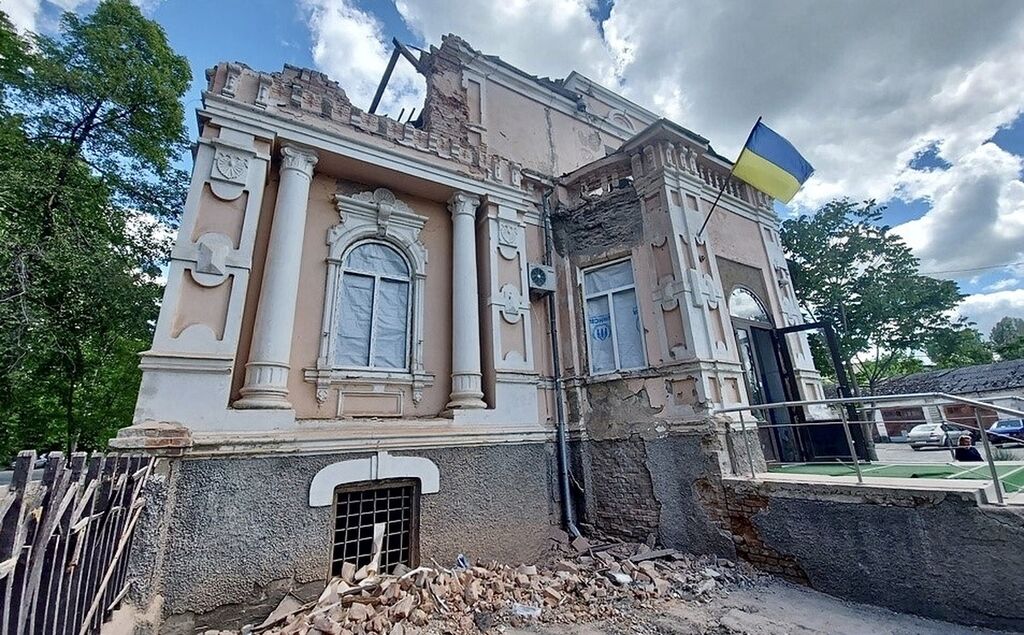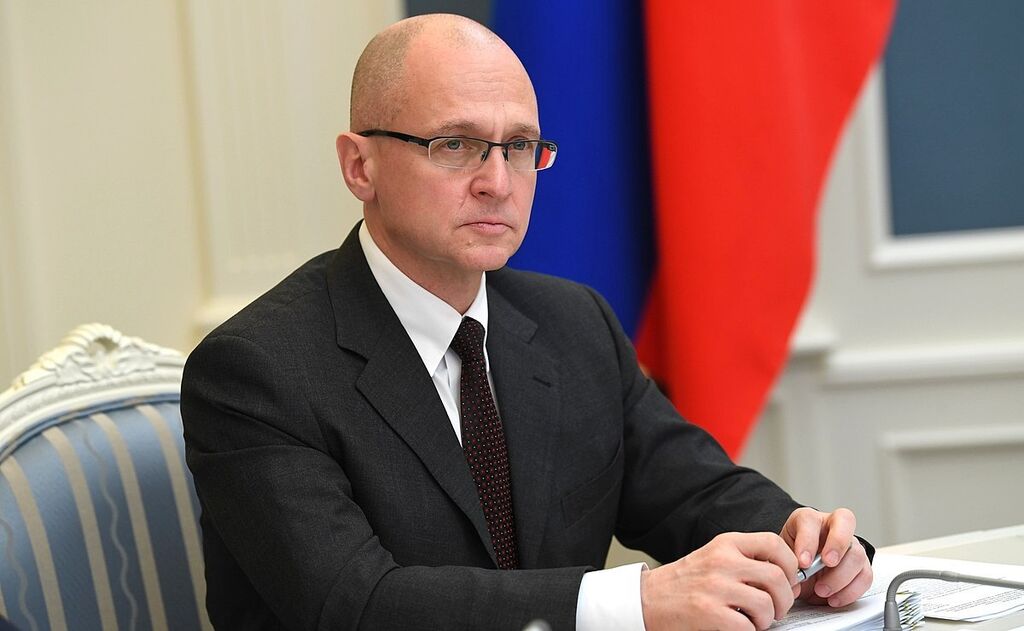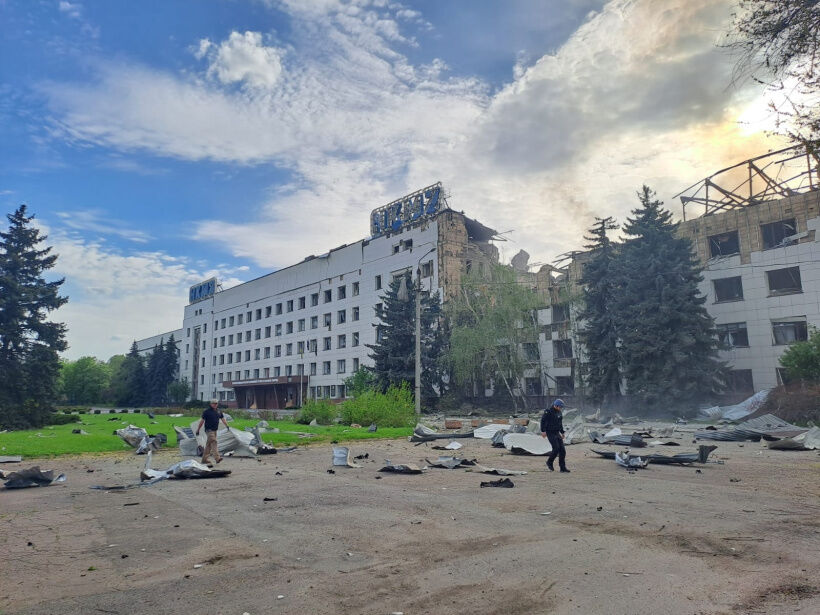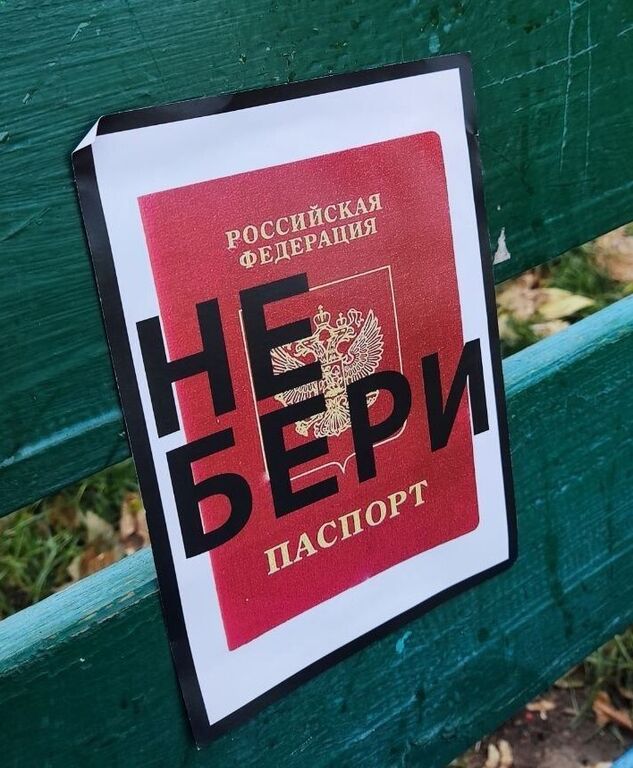Although Kremlin propaganda has attempted to present the occupied Donetsk, Luhansk, Kherson and Zaporizhzhia oblasts as permanent elements of the Russian Federation (RF), Russia’s policy does not demonstrate this commitment. Russia does not show interest in building up lasting institutions or care for the local population. Instead, the basic instruments of Russia’s policy include terror, forced passportisation of the local population, brutal Russification and indoctrination.

Orikhiv city council after Russian shelling 21 May 2022
By Maria Domańska, Iwona Wiśniewska, Piotr Żochowski
Territory and population ruled by force
The four regions of Ukraine which Russia formally annexed on 30 September 2022 are governed in a different manner than the rest of the RF and occupied Crimea. Russia never controlled 100% of these territories, and the scope of its possessions has decreased since the annexation. Large numbers of local residents have left these areas, and the majority of those who stayed in occupied Zaporizhzhia and Kherson oblasts have anti-Russian views.
The most important Russian institutions responsible for ‘maintaining order’ in the occupied regions include the military, the FSB, the interior ministry and Rosgvardiya. The Presidential Administration, coordinates personnel policy. The new regions are governed by civilian-military occupying authorities consisting of both local collaborators and Russian public servants & law enforcement officers. In these territories, the basic instruments of Russia’s policy include terror, the de facto forced passportisation of the local population, brutal Russification and indoctrination, and an expanding array of legal provisions for keeping the local residents under supervision.
These measures have eliminated any prospects for the emergence of a guerilla movement and other forms of organised resistance, including peaceful ones. According to information obtained in July by the National Resistance Centre of Ukraine, the Russians are planning to arrest 5000 individuals whom they suspect of being ready to manifest active resistance. Expressing attachment to Ukrainian identity is viewed as a serious anti-state crime.
The basic instruments of Russia’s policy include terror, the de facto forced passportisation of the local population, brutal Russification and indoctrination.
According to the Russian interior ministry, currently more than 2.2 m inhabitants of the four regions have been granted Russian citizenship, and a total of 83% of the local residents have applied for it. Although these figures cannot be verified, there is no doubt that mass-scale coercion has been introduced to force local residents to accept Russian passports. The Russian authorities have also procedures (which are illegal according to international law) which enable these individuals to renounce their Ukrainian citizenship. Children born in Kherson and Zaporizhzhia oblasts since 24 February 2022 have automatically been granted Russian citizenship. In April 2023, Putin signed a decree enabling deportation (starting from 1 July 2024) from the annexed territories of individuals who refuse to assume Russian citizenship.
The invaders have pursued a consistent policy of erasing the local population’s Ukrainian identity. School curricula have been transformed to match Russian textbooks,which indoctrinate children and youth in a spirit of contempt for everything Ukrainian and cultivate an adoration for Russia instead. Attempts to replace Ukrainian by Russian in schools have been made. Historical propaganda haphazardly combines elements of the Soviet-era ‘brotherhood of nations’ with Great Russian chauvinism and the Putinist quasi-ideology of the ‘russkiy mir’.
All Russia assists in the ‘reunification’
In the annexed regions, instruments of governance include the formula of imposing ‘custody’ of selected towns and villages located in the occupied territories on individual cities & regions of the RF proper. This concept was devised by Sergey Kiriyenko, First Deputy Chief of Staff of the Presidential Administration of the Russian Federation, who is responsible for domestic policy. The mechanism is intended to both fake grassroots support in Russia for the annexation, and to make the local Russian elites jointly responsible for the crimes of aggression, occupation and genocide. Over 80 Russian regions are involved in the reconstruction of the occupied territories.

Sergey Kiriyenko in 2020 (Photo: Wikemedia Commons)
Kiriyenko has staffed the governance structures in the occupied territories with trusted individuals to consolidate his own position. However, the Kremlin has encountered difficulties in recruiting the executive staff. Although job opportunities involving a transfer to Ukraine were presented as an attractive path, potential employees considered them unsafe and lacking career prospects. Also Ukrainian collaborators cannot hope to become legitimate elements of the Russian nomenklatura. Public servants are required to take part in tours to the occupied territories which last several months; some view these trips as an opportunity to avoid being punished for specific crimes such as corruption. The authorities’ attempt to attract physicians and teachers by offering them high salaries has proved more successful, especially in the case of residents of the RF’s least affluent regions.
Russian propaganda has reported extensively on the annexation, presenting it as a triumph for Moscow. It claims that the local population is enthusiastic about the ‘reunification with the motherland’ and living life normally. However, Ukrainian sources argue that the living standards remain very low, and the crisis is expected to worsen in wintertime. The fake elections held in the occupied territories on 8–10 September 2023 and the newly established Day of Reunification on 30 September are intended to consolidate the government’s narrative among the Russian people. However, the celebrations organized in Russia on the first anniversary of the annexation were modest.
Unlike the annexation of Crimea in 2014, the seizing of another four regions of Ukraine has not sparked any particular enthusiasm among Russian citizens.
Unlike the annexation of Crimea in 2014, the seizure of another four regions of Ukraine has not sparked any particular enthusiasm among Russians citizens. Despite this, in polls Russians tend to express views which fall in line with the official propaganda. In a poll conducted in August 2023 by the Levada Center, 71% of respondents were opposed to any concessions to Ukraine even if they could foster the end of the ‘special military operation’ and the signing of a peace agreement (45% of them were ‘strongly opposed’ to concessions). To a great extent, this is a result from the fact that the invasion is presented in Russian state media as ‘Russia’s existential defensive war against the absolute evil of Nazism’ and the entire NATO war machine.
Kyiv’s attitude towards the occupied territories
The Ukrainian authorities view the occupation as temporary and the annexation as unlawful. Criminal cases have been opened against Russian officials in absentia. Issues related to the situation in the annexed territories are being dealt with by the Ministry of Reintegration of the Temporarily Occupied Territories of Ukraine. Initially, the ministry’s priority tasks included organising the evacuation of the local residents and providing them with financial and humanitarian aid. A year after the annexation, this is no longer possible. Despite this, financial assistance continues to be offered to individuals remaining in the occupied territories and to those who have been displaced to areas controlled by Kyiv.
Kyiv has focused on moves to undermine the effectiveness of the occupation authorities and to prevent Russification and collaboration. On 15 March 2022, collaboration with the aggressor state, as well as supporting views which justify the Russian invasion, became a criminal offence punishable by 10 to 15 years imprisonment. The legislation is intended to have a deterring effect and to encourage people to assist in identifying the collaborators. Residents who are not directly involved in any actions against Ukraine are viewed as hostages to circumstances. Kyiv has also consented to Ukrainian nationals assuming Russian citizenship for security reasons.
So far, more than a dozen people belonging to the occupation authorities have been eliminated. The most spectacular one was the assassination of Kirill Stremousov, deputy head of the Kherson occupation administration. Several facilities occupied by the Russian-imposed authorities were also destroyed. This is an element of long-term psychological warfare.
The plunder economy
Information regarding the current economic situation in the occupied regions is limited, impossible to verify and used by both Russia and Ukraine as a propaganda tool. It is beyond doubt, however, that a major portion of these territories’ potential has been destroyed as a result of the invasion. The prolonged war hampers the reconstruction and contributes to further degradation.
The current economic potential of these territories is of limited importance to the Russian Federation. According to forecasts prepared by the Russian Ministry of Economic Development (which are not very reliable), in 2023 the nominal value of the gross regional product of the four annexed regions is expected to be around 2 trillion roubles (around $24bn), more than 1% of Russia’s GDP. According to Ukrainian statistics, a very similar figure was recorded in these oblasts in 2021, before the invasion. Until 2014, when they were partly seized by Russia, Donetsk and Luhansk oblasts had been Ukraine’s most industrialised regions. They were home to metallurgical, coal mining and electricity generation works & enterprises. Zaporizhzhia oblast had been the centre of Ukraine’s electromechanical industry.
The Russian occupation has triggered an influx of Kremlin loyalists interested in making quick profits rather than in developing business taking over local assets. Since 2014 the annexed territories have been affected by an exploitative economic policy: the Kremlin-controlled self-proclaimed authorities of the Donetsk and Luhansk People’s Republics have effectively nationalised the most attractive industrial facilities and mines. They have granted exclusive administration and production rights to private organisations linked to individuals such as Sergey Chemezov (head of the Rostech state-controlled company and Putin’s close aide from their time together in the KGB).

New Kramatorsk Machinebuilding Factory after Russian rocket strike on 5 May 2023 (Photo: Wikemedia Commons)
Similar practices have been recorded in the areas which Russia seized in 2022. In addition, local entrepreneurs were forces to re-register their companies in line with Russian law. As these regions are still a war zone, these assets have mainly been taken over by force, making it unlikely that the new owners will be able to legalise their ownership status in the future. In most cases, the former owners cannot hope for even partial payment or compensation. Few attempts to resume production in the seized industrial facilities have been made. The machines have been dismantled and the raw materials, stockpiled goods and finished products dispatched to Russia, amongst others by groups linked with Ramzan Kadyrov.
These Kremlin-linked individuals are also able to expand their fortunes with funds from the federal budget earmarked for the ‘reconstruction’ of the occupied territories. In 2023 almost 90% of the revenue of these territories consists in financial transfers from the Russian federal budget. They are expected to receive a total of almost 411bn roubles (around $5bn), of which Donetsk oblast will receive more than 171bn roubles. In practice, the entire sum consists of non-refundable, non-targeted subsidies which the local authorities disburse at their own discretion. The limited possibilities for supervising this spending increases the risk of embezzlement.
The federal authorities have also allocated funds to directly finance various initiatives sucha as infrastructure projects, the construction of public facilities and housing estates. Additionally, the authorities force Russian regional budgets and companies, mainly state-controlled ones, to finance various projects. However, there is little information on the size of these funds. It is likely that most of them are transferred to the private bank accounts of Kremlin-loyal individuals. Since the selection of investment contractors is discretionary, the risk of corruption is high. Most of the materials and workers involved come from Russia; local residents are hired rarely, and are usually paid much less than the non-local workforce
Russia’s deputy prime minister Marat Khusnullin is mainly responsible for the disbursement of the funds received from the federal budget. The Voyenno-Stroitelnaya Kompania, controlled by deputy defence minister Timur Ivanov, has also been involved in the distribution of state funds. As regards access to funds from regional budgets, these are usually offered to companies linked with the governors of those regions.

A poster from the Yellow Ribbon movement against forced passportisation, Ukraine, 4 June 2023 (Photo: Telegram channel Yellow Ribbon)
Conclusions and outlook
The development of the situation in the occupied territories will depend on the prospects for their liberation by the Ukrainian army. The Russian government realises that the annexed regions will not become an integral, internationally recognised part of Russia, and therefore has no interest in building up lasting institutions or care for the local population. It instead views the territories as an instrument for geopolitical blackmail against Kyiv and destabilising Ukrainian statehood.
Inhabitants of the occupied territories deemed disloyal by the occupational authorities risk deportation. They may lose all their rights, even after obtaining Russian passports, because (unconstitutional) Russian laws permit the authorities to strip individuals of their acquired citizenship. The areas which Russia needs for effective occupation will be staffed with individuals brought from Russia, changing local demographics.
The transfer of large sums of money from the budgets of the increasingly impoverished regions of the RF to the newly annexed oblasts, and the shortfall of workers in the Russian public utility sector may result in mounting frustration among the Russian public. This problem has been exacerbated by the war, the military mobilisation and the recruitment of personnel to be transferred to the occupied territories. This may pose a problem to the government, especially on the eve of the presidential election planned for March 2024. However, the figures publicly available do not contain any information on the public mood in this respect.
Should Russia decide that it is necessary to return the annexed regions, the Kremlin will likely be able to significantly mitigate its reputational damage on the domestic stage. The fact that its message dominates in the media space enables it to arbitrarily shape the attitudes of the Russian public, because they are highly susceptible to official narratives and quite indifferent to topics such as ‘Novorossiya’ and its ‘reunification with the motherland’.
This is a shortened version of an article first published on the OSW website.
